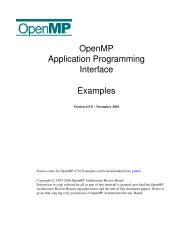D2 3 Computing e-Infrastructure cost calculations and business _models_vam1-final
D2 3 Computing e-Infrastructure cost calculations and business _models_vam1-final
D2 3 Computing e-Infrastructure cost calculations and business _models_vam1-final
You also want an ePaper? Increase the reach of your titles
YUMPU automatically turns print PDFs into web optimized ePapers that Google loves.
e-‐FISCAL: www.efiscal.eu <br />
EC Contract Number: 283449 <br />
OVH is a privately owned company in France that provides dedicated servers, mutual hosting, domain names <strong>and</strong> <br />
VOIP telephony services. The company offers localized services in France, Germany, Italy, Pol<strong>and</strong>, Spain, Irel<strong>and</strong>, <br />
United Kingdom, the Netherl<strong>and</strong>s <strong>and</strong> Finl<strong>and</strong> 59 . OVH has reported that it has reached 120,000 physical servers <br />
hosted in its datacenters 60 . The pricing policy of OVH for cloud services is simple, transparent <strong>and</strong> rather <br />
straightforward. OVH is a Europe-‐based company. While the <strong>cost</strong>s of in-‐house computing are on core hour basis <br />
the price charged by commercial providers is per instance hour. Therefore we had to assess the number of cores <br />
per instance <strong>and</strong> convert the commercial prices into price per core hour. As for Amazon, the type of instances that <br />
are relevant for e-‐FISCAL (http://aws.amazon.com/ec2/instance-‐types/) are the M/L/XL st<strong>and</strong>ard instances <strong>and</strong> <br />
the cluster compute quadruple extra-‐large instance 61 . <br />
Therefore the on-‐dem<strong>and</strong> prices for these services as well as the price of the reserved instances were used. Spot <br />
instances 62 are not considered relevant as Amazon proposes that spot Instances are better suited for time-‐flexible, <br />
interruption-‐tolerant tasks <strong>and</strong> warrens the user to be always prepared for the possibility that his/her spot <br />
instance is interrupted. Magellan (2011) does not also use prices of spot instances for comparisons. They support <br />
their decision on the fact that the runtime for a spot instance is unpredictable <strong>and</strong> application programmers need <br />
to design their applications to h<strong>and</strong>le pre-‐emption, which would not match the requirements for their <br />
applications. However, spot pricing does provide an estimate of the absolute lowest bound for pricing, since it <br />
essentially reflects the price threshold at which Amazon is unwilling to offer a service. <br />
The <strong>cost</strong> per core hour for the EC2 services was calculated as followed: <br />
1. The prices for on dem<strong>and</strong> instances <strong>and</strong> reserved instances were identified in Amazon’s site <br />
(http://aws.amazon.com/ec2/pricing/) for both Linux <strong>and</strong> Windows. The prices refer to EU (Irel<strong>and</strong>) but <br />
when such services are not provided in the EU the prices of West Virginia are used for purposes of <br />
completeness of the analysis. All reserved instances refer to heavy use. <br />
59 http://en.wikipedia.org/wiki/OVH#cite_note-‐dcn2009-‐12 <br />
60 http://www.datacenterknowledge.com/archives/2009/05/14/whos-‐got-‐the-‐most-‐web-‐servers/ (accessed 31/1/2013) <br />
61 In order to compare the like with like, a mapping has been done between the HPC/HTC infrastructures specified by the <br />
respondents of the e-‐FISCAL survey <strong>and</strong> the Amazon EC2 instances. Below are the two working examples of how this mapping <br />
is achieved. Case 1: Centre X has specified its infrastructure as follows: 2 hexa-‐core Xeon 5650 “westmere” 2.66GHz cpu’s <br />
24GB RAM. Now, each compute node is equivalent to 12 (2x6) cores <strong>and</strong> it can be roughly mapped to 1.5 X Cluster Compute <br />
Quadruple X-‐Large instance from EC2. The total number of cores in a Cluster Computer Quadruple X-‐Large is: 2 X 4 = 8, so 1.5 <br />
X 8 = 12 cores <strong>and</strong> it has 23 GB memory. Case 2: A Centre Y has specified its infrastructure as follows: HP Bl2x220c G5, L5420, <br />
4 core/CPU, 2.5 GHz, 16 GB RAM. Now, each compute node is quad core <strong>and</strong> it can be mapped to M1 X-‐Large instance within <br />
EC2 infrastructure. M1 X-‐Large instance has 4 virtual cores <strong>and</strong> it has 15 GB of memory. <br />
62 Spot Instances allow the user to name his/her own price for Amazon EC2 computing capacity. The user bids on spare <br />
Amazon EC2 instances <strong>and</strong> run them whenever the bid exceeds the current Spot Price, which varies in real-‐time based on <br />
supply <strong>and</strong> dem<strong>and</strong>. According to Amazon the Spot Instance pricing model complements the On-‐Dem<strong>and</strong> <strong>and</strong> Reserved <br />
Instance pricing <strong>models</strong>, providing potentially the most <strong>cost</strong>-‐effective option for obtaining compute capacity, depending on <br />
the application. While spot instances perform exactly like other Amazon EC2 instances while running they differ, except for <br />
lower price, in the fact that there is a possibility of being interrupted. This happens when the Spot price exceeds the max bid. <br />
e-‐FISCAL : Financial Study for Sustainable <strong>Computing</strong> e-‐<strong>Infrastructure</strong>s <br />
Deliverable <strong>D2</strong>.3 – <strong>Computing</strong> e-‐<strong>Infrastructure</strong>s <strong>cost</strong> estimation <strong>and</strong> analysis – Pricing <strong>and</strong> <br />
Business <strong>models</strong> <br />
52




